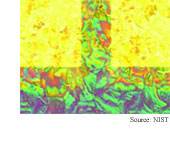|
NEWS
|
Self-healing rubber
Objects made of a self-healing rubber can be repaired
by simply joining the pieces at room temperature. The
rubber, whose polymer chains and the cross links between
them are formed by hydrogen bonds, can stretch to several
times its relaxed size. (Self-Healing
and Thermoreversible Rubber from Supramolecular Assembly,
Nature, February 21, 2008)
Gecko bandage
The latest gecko-inspired adhesive adds the twist
of biocompatibility, making the material potentially suitable
for bandaging wounds and replacing or augmenting sutures
and surgical staples. The material is also biodegradable
and could be modified to deliver drugs. The polymer's
surface is patterned with nanoscale pillars, which mimics
the surface of gecko feet. (A
Biodegradable and Biocompatible Gecko-Inspired Tissue
Adhesive, Proceedings of the National Academy of
Sciences, published online February 19, 2008)
Paint-on transistors
 Researchers have come up with a way to mass-produce
transistors that could lead to inexpensive ways of making
electronic devices, including electronic paper and flexible
displays. The process involves coating pairs of electrical
contacts with an organic semiconductor film. The key to
the process is first chemically treating the contacts
to cause the semiconductor material to crystallize only
between the contacts. The method eliminates the relatively
costly step of patterning the transistor channels. (Contact-Induced
Crystallinity for High-performance Soluble Acene-based
Transistors and Circuits, Nature Materials,
published online February 17, 2008)
Researchers have come up with a way to mass-produce
transistors that could lead to inexpensive ways of making
electronic devices, including electronic paper and flexible
displays. The process involves coating pairs of electrical
contacts with an organic semiconductor film. The key to
the process is first chemically treating the contacts
to cause the semiconductor material to crystallize only
between the contacts. The method eliminates the relatively
costly step of patterning the transistor channels. (Contact-Induced
Crystallinity for High-performance Soluble Acene-based
Transistors and Circuits, Nature Materials,
published online February 17, 2008)
Better dye solar cell
A better dye boosts the efficiency of dye-based
solar cells, which are less expensive but also less efficient
than traditional silicon solar cells. Researchers achieved
a 7.2% energy conversion efficiency using an optimized
dye that allows the cells to be thinner. Making cells
thin is key to using non-solvent electrolytes in dye-based
solar cells. Solvent electrolytes are less stable and
cost more because they have to be encapsulated. (Organic
Dye-Sensitized Ionic Liquid Based Solar Cells: Remarkable
Enhancement in Performance through Molecular Design of
Indoline Sensitizers, Angewandte Chemie International
Edition, February 22, 2008)
Optical breathalyzer
A laser spectroscope analyzes human breath to
detect substances that indicate disease. The device works
in real-time and detects many substances at once by using
an optical frequency comb, which separates laser light
into a series of narrow, closely spaced frequency bands
over a broad bandwidth. Specific types of molecules absorb
unique sets of frequencies, making it possible to identify
the molecules. (Cavity-Enhanced
Optical Frequency Comb Spectroscopy: Application to Human
Breath Analysis, Optics Express, February 18,
2008)
Magnetic cloak
Add magnetism to the cloakability list, joining
light and sound. A metamaterial made of superconducting
plates shields objects from static magnetic fields. The
magnetic cloaking device could be used to protect electronic
circuits and shield sensitive sensors from interference.
(A
D.C. Magnetic Metamaterial, Nature Materials,
published online February 24, 2008) |
FEATURES
|
View
from the High Ground: ICL's John Pendry
Physics as machine tool, negative refractive
index, metamaterials, shattered wine glasses, higher capacity
DVDs, scientific backwaters, risk perception and practice,
practice, practice.
|
How
It Works: Quantum computing: qubits
Photons, electrons and atoms, oh my! These particles are
the raw materials for qubits, the basic building blocks
of quantum computers. |
|
 |
News RSS feed 
Blog RSS feed 
Bookshelf RSS feed

New: TRN's
Internet Services
TRN's Jobs Center
|
| |
|
| |
|
| |
"Physics
is to the rest of science what machine tools are
to engineering. A corollary is that science places
power in our hands which can be used for good or
ill. Technology has been abused in this way throughout
the ages from gunpowder to atomic bombs."
- John Pendry, Imperial College London |
|
| |
|
| |
Thanks
to Kevin from
GoldBamboo.com
for technical support |
|

